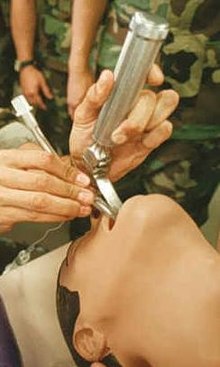Laryngoscopy

A laryngoscope (larynx+scope) is a medical instrument that is used to obtain a view of the vocal cords and the glottis, which is the space between the cords.
Rigid laryngoscope
A rigid laryngoscope is used for direct laryngoscopy (visualizing the larynx). It consists of a handle (incorporating two batteries) and an interchangeable blade with a bulb light source. The original blade was a straight Magill [[1]] and this design is still the standard pattern veterinary laryngoscopes are based upon; however the blade is difficult to control in adults and causes pressure on the vagus nerve, which can cause unexpected cardiac arrhythmias to spontaneously occur in adults.
There are many types of laryngoscope blades. The two main types are the curved Macintosh blade and the straight Miller (or Robertshaw) blade.. The Macintosh blade sits anterior to the epiglottis and raises it out of the visual pathway, while the Miller blade sits posterior to the epiglottis, trapping it while exposing the glottis and vocal cords. Incorrect usage can cause trauma to the front Incisor teeth; the correct technique is to lift the chin upwards and forward at the same time, not to use the blade as a lever with the teeth serving as the fulcrum.
The Miller and Robertshaw blades are usually used for infants, this is due to the larger comparative size of the epiglottis, which makes the Macintosh blade less effective.


Direct laryngoscopy is carried out (usually) with the patient lying on his or her back; the laryngoscope is inserted into the mouth on the right side and flipped to the left to trap and move the tongue out of the line of sight, and, depending on the type of blade used, either inserted anterior or posterior to the epiglottis and then lifted with an upwards and forward motion. This move makes a view of the glottis is possible. This procedure is most often employed in tracheal intubation. It is extremely uncomfortable and is not performed on conscious patients, or on patients with an intact gag reflex.
It is performed to facilitate endotracheal intubation as part of general anesthesia or CPR (cardiopulmonary resuscitation) during cardiac arrest.
The invention of the laryngoscope is hotly disputed; some claim it was invented by Manuel García, Professor of Music, and singing teacher for Jenny Lind, the "Swedish Nightingale"; whilst other medical giants (Morell Mackenzie writing in 1865) claim it was Benjamin Guy Babington.
Transnasal Flexible Laryngoscope
A transnasal flexible laryngoscope can be used for office-based diagnostics. The patient remains wide awake during the procedure, so the vocal cords can be observed during speech or singing. Surgical instruments passed through the scope can be used for performing procedures such as biopsies of suspicious masses.
